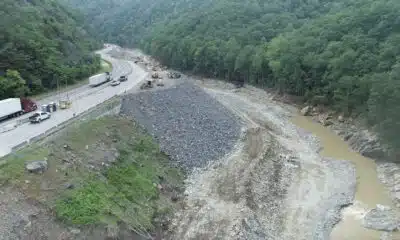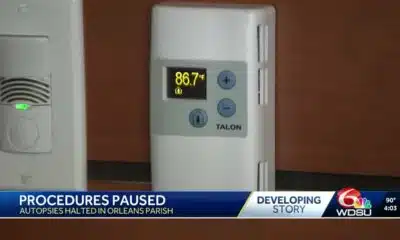News from the South - Oklahoma News Feed
High School Basketball Soon to be on the Clock – The Davis News
SUMMARY: The Oklahoma Secondary Schools Activities Association (OSSAA) voted 11-3 to implement a 35-second shot clock starting in the 2026-2027 season for Classes 3A to 6A high school basketball. Smaller schools in Classes 2A, A, and B may opt to use the shot clock in non-playoff games if both teams agree and NFHS approves. Some coaches, like Davis AD Jeff Brown, prefer the traditional game and worry about costs and logistics, while others, like former Davis assistant Stefan Hunt, support the change for faster, more exciting games. The shot clock was previously rejected by OSSAA in 2023 but is common in 30 states now.
The post High School Basketball Soon to be on the Clock – The Davis News appeared first on www.davisnewspaper.net
News from the South - Oklahoma News Feed
FEMA Cuts Sink Norman’s Automated Flood Warning Plan
The city of Norman was prepared to build an automatic flood warning system this year, the same kind of early warning system that Kerr County, Texas, could have used to help save lives during the deadly floods over the July Fourth weekend.
But in April, the Trump administration said it was ending the wasteful and ineffective program that would have paid for it. The city, which dealt with flooding as recently as June, was forced to table its $313,000 project to install automated sensors and cameras to monitor water levels and provide real-time alerts to the public.
“Now we don’t have that automated system that we would very much like to have if there was funding available for it,” Tiffany Vrska, a spokesperson for the city of Norman, said of the administration pulling back the Federal Emergency Management Agency’s Building Resilient Infrastructure and Communities program.
President Donald Trump’s administration has systematically reduced states’ access to resources to safeguard their people against natural disasters, frustrating city and state leaders across the country, including from communities that overwhelmingly voted for Trump.
“I’m a super big fan of the president, but I’m going to challenge him any time he gets something wrong,” Central, Louisiana, Mayor Wade Evans said.
Central regularly faces flooding, and a disastrous 2016 flood submerged thousands of homes and other structures in the city of about 30,000 just east of Baton Rouge.
A FEMA grant for $39 million was intended to stop a cycle of repeated flooding, damage and repair for hundreds of structures in the city. Evans estimated that the project, by creating new retention areas for flood waters, would save more than $100 million in projected losses over time.
“I never thought I would have to evacuate my neighborhood,” Evans said. “Have my kids evacuated on a boat, crying. This isn’t wasteful at all. This is actual brick-and-mortar solutions that have nothing to do with politics.”
While the administration is backtracking on Trump’s initial proposal to completely eliminate FEMA, the agency has been relentless in continuing to cut programs aimed at lessening the catastrophic impact of future disasters.
In February, the Trump administration took down the application for the Flood Mitigation Assistance Grant Program, which was supposed to make $600 million in grants available this year to reduce long-term flood risks, especially for properties that are covered by government-funded flood insurance. The Biden administration opened applications for the latest round of that program in January, and some states were already preparing lists of places that badly need support.
Then, in April, FEMA retracted both awarded and planned grants for well over 50 communities under the BRIC program, including Norman and Central.
The administration maintains that the disaster resilience program was wasteful, despite Trump signing the law creating the program in 2018.
“BRIC was yet another example of a wasteful and ineffective FEMA program. It was more concerned with climate change than helping Americans affected by natural disasters. We are committed to ensuring that Americans in crisis can get the help and resources they need,” a Department of Homeland Security spokesperson said in a written statement.
This term, Trump also ended the standard practice of granting funding for hazard mitigation when states experience a major federal disaster, including for Texas. Texas’s request for hazard mitigation funding is pending.
Many states, including Oklahoma, Iowa, Missouri and Mississippi, were ultimately denied hazard mitigation funds this year. Trump also denied North Carolina’s request for FEMA to match 100% of the state’s investment in recovery from Hurricane Helene this year, reversing an offer set by the Biden administration.
In September 2023, an intense storm swept rapid flooding through homes, cars and bridges in Scranton, Pennsylvania. Over the course of a long night, the city sent firefighters in rescue boats to pull people trapped in flooding homes. The firefighters saved lives, but no one could save the homes.
Now, more than a year later, those homes still stand rotting and uninhabitable. It’s not safe to rebuild them, and it will never be safe for anyone to live there again.
Scranton applied for a $2.5 million BRIC grant to buy the homes from their owners, knock them down, and turn them into soccer fields — areas that can be used by the community when the weather is normal and safely flood when the weather turns extreme.
“To hear about FEMA pulling this down was a shock,” Scranton Mayor Paige Cognetti said.
She said she doesn’t know where the city will find the money to buy the ruined homes, but she knows that it needs to happen.
“This was a $10 million storm,” Cognetti said. “I can’t sustain another $10 million storm, our coffers don’t have that, there’s just no well to go back to.”
Cognetti is a Democrat. In Congress, her city is represented by freshman House Republican Rep. Rob Bresnahan, who won Trump’s endorsement and has voted for the president’s priorities. On FEMA, however, Bresnahan wants the administration to reverse course.
“This one is pretty close to the heart here. I remember sand-bagging my grandparents’ house,” he said, talking about floods that filled their first floor with four feet of water. “The first time you remember the smell of flood mud, it’s something you’ll never forget.”
Bresnahan is one of several House and Senate Republicans to challenge the White House on pulling the BRIC program by introducing a bill with bipartisan sponsorship that would require FEMA to disburse the funds. He is planning on introducing a second piece of legislation this week that would require FEMA to study the effectiveness of its hazard mitigation efforts, he said.

“I don’t feel this is a partisan issue,” Bresnahan said. “This is about keeping our community safe and our infrastructure reliable. We have to do something. These small communities just don’t have the available capital to be able to make these investments independently.”
Other Republicans have also challenged FEMA on the BRIC program in hearings and letters: Oklahoma Rep. Tom Cole, Louisiana Sen. Bill Cassidy, Alaska Sen. Lisa Murkowski, and North Carolina Sen. Thom Tillis.
So far, their advocacy hasn’t succeeded. The BRIC grantees who spoke with Oklahoma Watch have not been able to restore their funding, even after Evans, the Central, Louisiana, mayor, came to Washington, D.C. to meet with the Louisiana delegation and other interested Republicans.
“I’ve had no luck trying to talk to FEMA,” Evans said. “You take our tax dollars up there in Washington, and you give us a set of guidelines, and we follow everything to a T. We spend the money putting the application together, and you award us the project, and then, with all the whims of an administration, you take it from us. And I’m talking about an area that has overwhelmingly supported the president’s agenda.”
The kinds of floods that killed more than 100 people, including dozens of children, along the Guadalupe River in Texas this month are becoming increasingly frequent in the United States.
About 90% of U.S. disasters involve flooding, as the number of floods with catastrophic effects increase globally. After heat-related deaths, floods are the leading cause of weather-related deaths in the United States. Severe flooding events after periods of intense rainfall, like what happened in Texas (either overwhelming rivers or overwhelming sewer systems) have become more common in the United States over the last several decades, according to research from the First Street Institute and U.S. Geological Survey data.
“The water is coming down at a pace that municipalities cannot keep up with,” Cognetti said. “It’s cities, it’s rural counties, you name it, the water doesn’t discern.”
Other communities that lost their BRIC program funding include Wood River, Nebraska; Crisfield, Maryland; Forsyth, Montana; and Goldsboro and Taylorsville, North Carolina. Approximately 60% of the projects awarded funds through BRIC in 2024 were in counties that voted for Trump in the most recent election.
The Trump administration isn’t just removing funding, it’s also reducing disaster mitigation regulations. In March, FEMA revoked the requirement that structures like hospitals, wastewater treatment plants and fire stations damaged in previous floods be designed to withstand greater risks if they want to use federal money to rebuild. The Trump administration argued the rules, first introduced under President Obama, repealed during Trump’s first term, and then reintroduced under Biden, slowed recovery.
“They know what their hazards are,” Deanne Criswell, FEMA administrator under Biden, said. “They know what they need to do to reduce the impact. Yet now we’ve taken away that funding source. This is how we should be spending our taxpayer dollars. We should be doing smart investments so that we don’t have to respond, so that we don’t have to recover as much.”
The U.S. Chamber of Commerce, in collaboration with insurance provider Allstate, found that every $1 spent on disaster preparedness leads to about $7 saved in economic costs for a community, in a 2024 study looking at 25 disaster scenarios. The National Institute of Building Sciences found that for every $1 invested in resilience, communities save anywhere from $4 to $11 in future losses, depending on where in the country the disaster happens. Those studies also conclude that communities receive economic benefits from those types of investments even if no disaster strikes.
“This isn’t wasteful at all. This is actual brick-and-mortar solutions that have nothing to do with politics.”
Wade Evans
“If we are going to provide disaster assistance to individuals and to communities to repair, why should we not have an additional source of funding to break that cycle so that we’re not perpetually providing repair assistance?” said Chad Berginnis, the executive director of the Association of State Floodplain Managers.
“It’s a good investment for the taxpayer,” he said. “Disaster assistance is a good leg up for the individual and the business owner and the community, but mitigation is an overall good investment for taxpayers because it breaks the cycle.”
That hasn’t been the administration’s view. From the beginning, Trump and top administration officials have said they would like local governments to lead recovery efforts.
“FEMA will continue to support Americans impacted by disasters no matter the state or jurisdiction they live in, allowing local governments to lead the response managed by their states,” the DHS spokesperson said.
DHS did not specify how possible changes to FEMA’s structure would impact states’ budgets.
The president’s budget proposal to Congress included language referring to the BRIC program that appeared to recognize its value, stating: It “mitigates against the impacts of natural hazard to lower future disaster costs.” The budget did not specify whether the administration plans to direct any funding toward it or disperse any awarded grants.
The budget document has similar language praising the hazard mitigation grant funding that Trump has been denying states since April.
“HMGP reduces future need for Federal disaster assistance by reducing the impact of and increasing the resistance to natural disasters,” it reads.
Still, local leaders have no idea how much money they are going to be expected to find for disasters.
“The very real possibility that FEMA is not going to be there for us financially or even operationally, it’s scary,” Cognetti said. “It’s scary about saving people’s lives, it’s scary because we won’t be able to proactively mitigate things as well, and it’s scary from a public safety standpoint.”
This article first appeared on Oklahoma Watch and is republished here under a Creative Commons Attribution-NoDerivatives 4.0 International License.
The post FEMA Cuts Sink Norman’s Automated Flood Warning Plan appeared first on oklahomawatch.org
Oklahoma Watch, at oklahomawatch.org, is a nonprofit, nonpartisan news organization that covers public-policy issues facing the state.
Note: The following A.I. based commentary is not part of the original article, reproduced above, but is offered in the hopes that it will promote greater media literacy and critical thinking, by making any potential bias more visible to the reader –Staff Editor.
Political Bias Rating: Center-Left
This article presents a critical perspective on the Trump administration’s handling of federal disaster mitigation funding, highlighting cuts to programs aimed at flood prevention and community resilience. It emphasizes the negative impact on local governments and communities, including those that supported Trump, and underscores the importance of federal investment in disaster preparedness. The tone favors proactive government involvement and accountability, reflecting a viewpoint generally aligned with center-left priorities on public infrastructure and climate-related risks. However, it includes voices from both political sides and refrains from overt partisan language, maintaining a largely factual but critical stance.
News from the South - Oklahoma News Feed
Convicted sex offender added to top 10 most wanted list
SUMMARY: Anthony Michael Lennon, a convicted sex offender, has been added to Oklahoma’s top 10 most wanted list 13 years after disappearing. Lennon was last seen in 2012 when he allegedly was a kidnapping and robbery victim, but he’s now wanted on eight child-related counts dating back to 2012. Previously convicted on five counts of aggravated possession of child pornography, Lennon was sentenced to 20 years in prison but placed on supervised release when he vanished. Authorities question how he evaded capture for so long. The attorney general warns Lennon may be using an alias and emphasizes the urgent need to hold him accountable.
Convicted sex offender added to top 10 most wanted list Stay informed about Oklahoma news and weather! Follow KFOR News 4 …
News from the South - Oklahoma News Feed
Police say couple had 50+ animals living in home
SUMMARY: An Oklahoma couple is accused of hoarding more than 50 animals inside their El Reno home, which investigators describe as unlivable for both pets and humans. Court documents revealed the house contained dogs, cats, rabbits, ferrets, bearded dragons, turtles, fish, and a bird. The home was condemned months earlier as a public nuisance due to overwhelming filth and odor, with floors covered in feces and many animals confined in filthy cages. Police and animal control intervened after a tip, leading to arrests including the husband’s last month. All animals were transferred to humane care for recovery.
KFOR 10pm newscast Stay informed about Oklahoma news and weather! Follow KFOR News 4 on our website and social …
-
News from the South - Tennessee News Feed1 day ago
Bread sold at Walmart, Kroger stores in TN, KY recalled over undeclared tree nut
-
News from the South - North Carolina News Feed7 days ago
Learning loss after Helene in Western NC school districts
-
News from the South - Missouri News Feed7 days ago
Turns out, Medicaid was for us
-
Local News7 days ago
“Gulfport Rising” vision introduced to Gulfport School District which includes plan for on-site Football Field!
-
News from the South - Missouri News Feed6 days ago
Leawood changes street tree ordinance, launches sidewalk repair program
-
News from the South - Louisiana News Feed7 days ago
With brand new members, Louisiana board votes to oust local lead public defenders
-
Mississippi Today4 days ago
Hospitals see danger in Medicaid spending cuts
-
News from the South - Florida News Feed6 days ago
The Bayeux Tapestry will be displayed in the UK for the first time in nearly 1,000 years











































